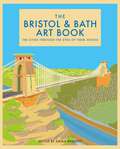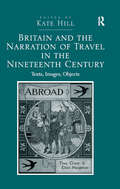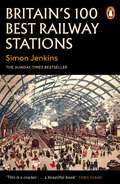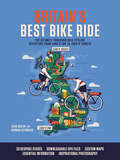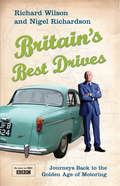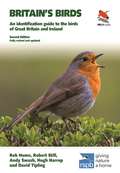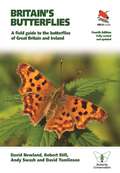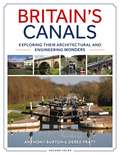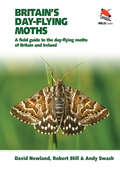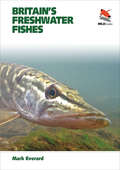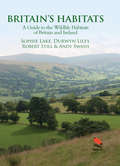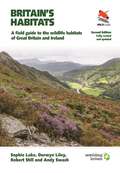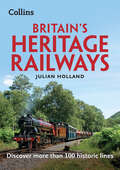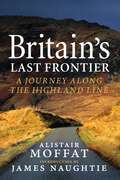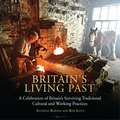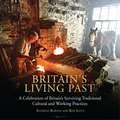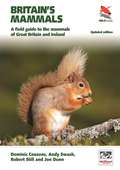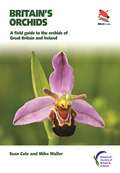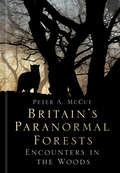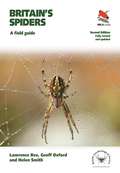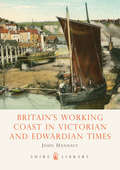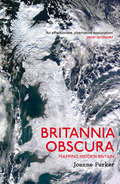- Table View
- List View
The Bristol and Bath Art Book: The cities through the eyes of their artists (The city through the eyes of its artists)
by Emma BennettBristol and Bath are two beautiful, closely connected cities. They are portrayed through the eyes of their artists in a delightful variety of styles in this stunning book.The Bristol and Bath Art Book portrays two very different cities. The beautiful images in the book capture the breath-taking landscape of rivers, hills and gorges which they share, but also the cities' sights that are so unique. Bristol is painted as busy, quirky and vibrant, where Bath glows in more tranquil hues. These important cities in the history of the world are intimately connected.The river Avon that flows through both cities, gouges the spectacular Avon Gorge at Bristol, which is where its international maritime connections begin.The regenerated old docks (the 'floating harbour'), Wapping Wharf and the quayside are lovingly depicted by various artists. Now that the main docks are outside the city, the harbour-side now bustles with shops, bars and offices, but there are still cranes to be seen at the M shed. Underfall boatyard remains a home to maritime businesses and is also pictured in this lovely book, along with pleasure craft and houseboats in the harbour.John Cabot's The Matthew is the ship that put America on the map. The reconstruction is depicted in drawings and paintings. She may have been a pirate ship at one time, too, as Bristol was the birthplace of Blackbeard and had a thriving piracy business.From this Atlantic connection, the list of items traded expanded from wool, wine and grain to tobacco and alas, to slaves. The profits from this trade endowed many of the fine public monuments drawn and painted here. Like many places, Bristol is undertaking a new reckoning with its history.The great engineer Isambard Kingdom Brunel designed the Clifton Suspension Bridge to span the deep Avon Gorge. In the book, there are many images of this vertiginous bridge: ringed by balloons, luminous in the gloaming, stark in the snow, or painted to resemble a cathedral arch from below. It is a much-loved, living monument to the great man.His Great Western Railway terminus at Temple Meads features here in drawings and prints, along with his pioneering Bristol-built steamship, the SS Great Britain.Crossing Brunel's famous bridge over the Avon, you will find yourself in the tranquil Leigh woods, painted as a hotspot for bluebells in spring.The old Railway Path, flat, traffic-free and lined with greenery, takes you from Bristol to Bath, where you will find more gorgeous parks: the Georgian garden in the town centre, Alexandra Park with panoramas of the city and the Botanical Gardens with its aerial walkway.Bath is a UNESCO world heritage site because of its Roman remains and exquisite Georgian architecture. Its famous Roman Baths were built around a hot spring the Romans believed sacred to the Goddess Sulis and the city became a centre for health and an inspiration for artists.Its 18th-century architecture: The Royal Crescent, The Circus, Pulteney Bridge and Assembly Rooms, are all examples of Bath's heyday as a Georgian spa town and are featured in the art book in stunning paintings, drawings and collages.They capture the Bath that Jane Austen would have known from her time in the city. Here, movies of some of her novels have been filmed, along with many other Regency era series e.g. the record-breaking series Bridgerton.
Britain and the Narration of Travel in the Nineteenth Century: Texts, Images, Objects
by Kate HillInterrogating the multiple ways in which travel was narrated and mediated, by and in response to, nineteenth-century British travelers, this interdisciplinary collection examines to what extent these accounts drew on and developed existing tropes of travel. The three sections take up personal and intimate narratives that were not necessarily designed for public consumption, tales intended for a popular audience, and accounts that were more clearly linked with discourses and institutions of power, such as imperial processes of conquest and governance. Some narratives focus on the things the travelers carried, such as souvenirs from the battlefields of Britain’s imperial wars, while others show the complexity of Victorian dreams of the exotic. Still others offer a disapproving glimpse of Victorian mores through the eyes of indigenous peoples in contrast to the imperialist vision of British explorers. Swiss hotel registers, guest books, and guidebooks offer insights into the history of tourism, while new photographic technologies, the development of the telegraph system, and train travel transformed the visual, audial, and even the conjugal experience of travel. The contributors attend to issues of gender and ethnicity in essays on women travelers, South African travel narratives, and accounts of China during the Opium Wars, and analyze the influence of fictional travel narratives. Taken together, these essays show how these multiple narratives circulated, cross-fertilised, and reacted to one another to produce new narratives, new objects, and new modes of travel.
Britain and the Narration of Travel in the Nineteenth Century: Texts, Images, Objects
by Kate HillInterrogating the multiple ways in which travel was narrated and mediated, by and in response to, nineteenth-century British travelers, this interdisciplinary collection examines to what extent these accounts drew on and developed existing tropes of travel. The three sections take up personal and intimate narratives that were not necessarily designed for public consumption, tales intended for a popular audience, and accounts that were more clearly linked with discourses and institutions of power, such as imperial processes of conquest and governance. Some narratives focus on the things the travelers carried, such as souvenirs from the battlefields of Britain’s imperial wars, while others show the complexity of Victorian dreams of the exotic. Still others offer a disapproving glimpse of Victorian mores through the eyes of indigenous peoples in contrast to the imperialist vision of British explorers. Swiss hotel registers, guest books, and guidebooks offer insights into the history of tourism, while new photographic technologies, the development of the telegraph system, and train travel transformed the visual, audial, and even the conjugal experience of travel. The contributors attend to issues of gender and ethnicity in essays on women travelers, South African travel narratives, and accounts of China during the Opium Wars, and analyze the influence of fictional travel narratives. Taken together, these essays show how these multiple narratives circulated, cross-fertilised, and reacted to one another to produce new narratives, new objects, and new modes of travel.
Britain's 100 Best Railway Stations
by Simon JenkinsThe perfect new gift from the bestselling author of Britain's 1000 Best ChurchesIt is the scene for our hopeful beginnings and our intended ends, and the timeless experiences of coming and going, meeting, greeting and parting. It is an institution with its own rituals and priests, and a long-neglected aspect of Britain's architecture. And yet so little do we look at the railway station. Simon Jenkins has travelled the length and breadth of Great Britain, from Waterloo to Wemyss Bay, Betws-y-Coed to Beverley, to select his hundred best. Blending his usual insight and authority with his personal reflections and experiences - including his founding the Railway Heritage Trust - the foremost expert on our national heritage deftly reveals the history, geography, design and significance of each of these glories.Beautifully illustrated with colour photographs throughout, this joyous exploration of our social history shows the station's role in the national imagination; champions the engineers, architects and rival companies that made them possible; and tells the story behind the triumphs and follies of these very British creations. These are the marvellous, often undersung places that link our nation, celebrated like never before.
Britain's Best Bike Ride: The ultimate thousand-mile cycling adventure from Land’s End to John o’ Groats
by Hannah Reynolds John WalshBritain’s Best Bike Ride by John Walsh and Hannah Reynolds is a beautifully illustrated and inspirational guide to the ultimate thousand-mile cycling adventure from Land’s End to John o’ Groats.There are many ways to cycle between Land’s End and John o’ Groats, but the route specially created for this book, LEJOG1000, is designed to show you the quiet roads, picturesque villages and dramatic landscapes that make the experience memorable. Instead of taking the most direct route, it invites you to explore the best of each region you pass through. You’ll discover stunning beaches and wild ponies on your way along the quiet wild-flower-edged lanes of Cornwall and Devon, follow the meandering River Wye in Wales, wind your way through a post-industrial landscape of canals and mill chimneys in the North West, before moving on to the epic climbs and grand vistas of Scotland.Carefully crafted to allow you the freedom to create your own ultimate adventure, the route is split into 30 adaptable stages, each finishing in a town or village with suggested places to eat, drink and stay. Create your own bespoke itinerary, or use one of three itinerary options provided: the 2-week classic, 3-week explorer or 10-day challenge. Along with stunning photography and lively insightful writing you will find all the practical information you need to plan your LEJOG1000 – route directions, bespoke mapping, cafes, pubs and local bike shops. Downloadable GPX files of the route are also available.Britain’s Best Bike Ride will inspire you to take on this once-in-a-lifetime challenge – you’ll be pedalling into John o’ Groats having experienced the very best of Britain on a bike before you know it!
Britain's Best Drives: Journeys Back To The Golden Age Of Motoring
by Nigel Richardson Richard WilsonBack in the fifties, motoring was a liberating experience. Before motorways, traffic jams and road rage, the leisurely Sunday drive could be the highlight of the week. Now, armed with period driving guides, Richard Wilson has packed his picnic, flask and himself into some very stylish vintage cars to retrace six classic routes through the UK and recreate the pleasure of the golden age of motoring for BBC TV.Including the dramatic winding roads of the North Cornwall coast, the lochs and peaks of the Central Highlands and the bronze-age monoliths of the North Yorkshire moors, Richard explores some of the most striking and beautiful scenery and landmarks Britain has to offer. Along the way he meets the people who live there and remember how these places once were, and wonders why things aren't what they used to be.
Britain's Birds: An Identification Guide to the Birds of Great Britain and Ireland Second Edition, fully revised and updated (WILDGuides #41)
by Rob Hume Robert Still Andy Swash Hugh Harrop David TiplingA new, improved and thoroughly updated edition of the bestselling photographic guide—the only one to cover every bird, in every plumage, ever recorded in Britain and IrelandA bestselling guide since it was first published, Britain's Birds has quickly established itself as the go-to photographic identification guide to the birds of Great Britain and Ireland—the most comprehensive, up-to-date, practical and user-friendly book of its kind. Acclaimed by birdwatchers of all kinds, from the beginner to the most experienced, the guide has now been thoroughly revised and updated to make it even better than before. Combining the finest of identification guide content and presentation, this eagerly awaited second edition preserves the best of the first edition while covering twelve newly recorded species and offering a host of improvements that make identification easier.Provides comprehensive coverage of all the birds ever recorded in Britain and IrelandDescribes and illustrates all plumages likely to be encounteredFeatures more than 3,200 stunning photographs carefully selected to show the birds as you really see themOutlines simple steps to help you identify any bird you seePresents simple and accurate comparisons of similar and difficult speciesNew features include:Coverage of 12 new species recorded since the first edition plus revisions to reflect the latest taxonomyCoverage of all subspeciesImproved identification aids, including more than 400 new photos, enhanced photo annotations and many redesigned platesFully revised species accounts, including the latest information on identification features, status, numbers, geographical range and date ranges for all plumages that may be seen during only part of the year
Britain's Butterflies: A Field Guide to the Butterflies of Great Britain and Ireland – Fully Revised and Updated Fourth Edition (WILDGuides #75)
by David Newland Robert Still Andy Swash David TomlinsonA new and improved edition of the popular photographic field guideBritain’s Butterflies is a comprehensive and beautifully designed photographic field guide to the butterflies of Britain and Ireland. Containing hundreds of stunning colour photographs, this extensively revised and updated new edition provides the latest information on every species ever recorded. It covers in detail the identification of all 59 butterfly species that breed regularly, as well as four former breeders, 10 rare migrants and one species of unknown status. The easy-to-use format will enable butterfly watchers—beginners or experts—to identify any species they encounter. Produced in association with Butterfly Conservation, this edition features new introductory sections to the main "types" of butterflies; updated distribution maps; a revised species order reflecting the latest taxonomy; revised sections on recording and monitoring, and conservation and legislation; and a new section on climate change.Stunning colour plates show typical views of each butterfly species, including the various forms and common aberrationsDetailed species profiles provide information on status and distribution, including up-to-date maps, and cover adult identification; behaviour; breeding habitat requirements; population and conservation; egg, caterpillar and chrysalis; and caterpillar foodplantsPhotographs of the egg, caterpillar and chrysalis for every breeding speciesSections on biology, where to look for and how to identify butterflies, and other essential information
Britain's Canals: Exploring their Architectural and Engineering Wonders
by Anthony Burton Derek PrattBritain's Canals is a charming and insightful exploration into the amazing architecture and engineering wonders that surround Britain's inland waterways – from the awe-inspiring 30-lock flight on the Worcester and Birmingham Canal, to the delightful chocolate-box lock-keepers' cottages that line the cut of every canal, to masterpieces such as the 18-arch Pontcysyllte aqueduct, the highest aqueduct in the world, to beautiful bridges, grand company buildings, the social hubs that were, and still are, canal-side pubs, plus so much more. In contrast to many inland waterways books which are organised geographically by canal, Britain's Canals is structured thematically, with chapters covering the line (the shape of the canal), locks and lock cottages, bridges, aqueducts, lifts and planes, company buildings, wharves, basins and quays and finally the canal-side pub. Each chapter explores how these features were created and have changed through history, right through to the present, with plenty of ideas for places to visit – plus full information on how to get to them. An abundance of full-colour photography throughout, both historical and modern-day, will delight readers and inspire them to explore Britain's wondrous inland waterways, whether on boat, by foot or by bike. In Britain's Canals, two inland waterways experts and admired authors come together to produce the definitive word on the man-made wonders that make Britain's canals so special, so loved and enjoyed by so many.
Britain's Canals: Exploring their Architectural and Engineering Wonders
by Anthony Burton Derek PrattBritain's Canals is a charming and insightful exploration into the amazing architecture and engineering wonders that surround Britain's inland waterways – from the awe-inspiring 30-lock flight on the Worcester and Birmingham Canal, to the delightful chocolate-box lock-keepers' cottages that line the cut of every canal, to masterpieces such as the 18-arch Pontcysyllte aqueduct, the highest aqueduct in the world, to beautiful bridges, grand company buildings, the social hubs that were, and still are, canal-side pubs, plus so much more. In contrast to many inland waterways books which are organised geographically by canal, Britain's Canals is structured thematically, with chapters covering the line (the shape of the canal), locks and lock cottages, bridges, aqueducts, lifts and planes, company buildings, wharves, basins and quays and finally the canal-side pub. Each chapter explores how these features were created and have changed through history, right through to the present, with plenty of ideas for places to visit – plus full information on how to get to them. An abundance of full-colour photography throughout, both historical and modern-day, will delight readers and inspire them to explore Britain's wondrous inland waterways, whether on boat, by foot or by bike. In Britain's Canals, two inland waterways experts and admired authors come together to produce the definitive word on the man-made wonders that make Britain's canals so special, so loved and enjoyed by so many.
Britain’s Day-flying Moths: A Field Guide to the Day-flying Moths of Britain and Ireland
by David Newland Robert Still Andy Swash Mark ParsonsThis concise photographic field guide will help you identify any of the 100 or so day-flying moths found in Britain and Ireland. Combining stunning photographs, authoritative text, and an easy-to-use design, this book makes a perfect traveling companion--one that will increase your enjoyment of these colorful and intriguing creatures. Like butterflies, some moths fly regularly in sunshine, whereas others that usually fly only at night are readily disturbed from their resting places during the day. This guide describes all of these species, with at least one photograph of each in its natural, resting pose. The text includes a brief description of each moth, with details of its life history, where and when to look for it, its status, the food plants of its caterpillars, and its special features. Introductory sections cover many topics, including how to distinguish moths from butterflies; classification; life cycle and behavior; ecological importance; the impact of habitat and climate change; recording and monitoring; and conservation. Individual accounts for some 100 species Stunning photographs of every moth, as you see them Attractive, easy-to-use, and accessible design
Britain’s Day-flying Moths: A Field Guide to the Day-flying Moths of Britain and Ireland (PDF)
by David Newland Robert Still Andy Swash Mark ParsonsThis concise photographic field guide will help you identify any of the 100 or so day-flying moths found in Britain and Ireland. Combining stunning photographs, authoritative text, and an easy-to-use design, this book makes a perfect traveling companion--one that will increase your enjoyment of these colorful and intriguing creatures. Like butterflies, some moths fly regularly in sunshine, whereas others that usually fly only at night are readily disturbed from their resting places during the day. This guide describes all of these species, with at least one photograph of each in its natural, resting pose. The text includes a brief description of each moth, with details of its life history, where and when to look for it, its status, the food plants of its caterpillars, and its special features. Introductory sections cover many topics, including how to distinguish moths from butterflies; classification; life cycle and behavior; ecological importance; the impact of habitat and climate change; recording and monitoring; and conservation. Individual accounts for some 100 species Stunning photographs of every moth, as you see them Attractive, easy-to-use, and accessible design
Britain’s Freshwater Fishes (PDF)
by Mark EverardBritain hosts a diversity of freshwater environments, from torrential hill streams and lowland rivers to lakes and reservoirs, ponds and canals, and ditches and estuaries. Britain's Freshwater Fishes covers more than 50 species of freshwater and brackish fish found in these waters. This beautifully illustrated guide features in-the-hand and in-the-water photographs throughout, and accessible and informative overviews of topics such as fish biology and life cycles. Detailed species accounts describe key identification features, with information on status, size and weight, habitat, ecology, and conservation. The book also includes a glossary and suggestions for further reading. This easy-to-use field guide will be invaluable to anyone interested in Britain's freshwater fish life, from naturalists and academics to students and anglers. Covers all of Britain's freshwater fishes Features beautiful photos throughout Includes detailed information on more than 50 species, the places they inhabit, and their roles in Britain's ecosystems Attractively designed and easy to use
Britain’s Habitats: A Guide to the Wildlife Habitats of Britain and Ireland (PDF)
by Sophie Lake Durwyn Liley Robert Still Andy SwashA photographic guide to habitats, this lavishly illustrated book provides a comprehensive overview of the natural history and conservation landscape of Britain and Ireland. In essence a field guide, the book leads the reader through all the main habitat types, with information on their characteristics, extent, geographical variation, key species, cultural importance, origins and conservation. It aims to help visitors to the countryside recognize the habitats around them, understand how they have evolved and what makes them special, and imagine how they might change in the future.This book is the perfect companion for anyone travelling in Britain and Ireland, and essential reading for all wildlife enthusiasts, professional ecologists and landscape architects.Individual sections on all the main habitat types found in Britain and IrelandMore than 680 evocative colour photographs, including images from around Britain and Ireland in all seasonsDetails and photographs of key species and features associated with the different habitatsUp-to-date information—including maps—on the distribution, extent and importance of all habitat typesInformation on key nature conservation designations and different systems of habitat classification
Britain's Habitats: A Field Guide to the Wildlife Habitats of Great Britain and Ireland - Fully Revised and Updated Second Edition (WILDGuides #76)
by Sophie Lake Durwyn Liley Robert Still Andy SwashA comprehensive and lavishly illustrated photographic guide—now in a handy field-guide formatThis lavishly illustrated photographic guide provides a comprehensive overview of the natural history of wildlife habitats in Britain and Ireland. Now completely redesigned in a handy field-guide format, and featuring revised and updated text throughout, this new edition of Britain’s Habitats guides readers through all the main habitat types, presenting information on their characteristics, extent, geographical variation, key species, cultural importance, origins and conservation. It aims to help visitors to the countryside recognize the habitats around them, understand how they have evolved and what makes them special, and imagine how they might change in the future. This new edition includes updated maps and additional photographs throughout, and covers a new habitat—gardens. The perfect companion for anyone travelling in Britain and Ireland, the book is essential reading for all wildlife enthusiasts, professional ecologists and landscape architects.Individual sections on all the main habitat types found in Britain and IrelandMore than 680 evocative colour photographs, including images from around Britain and Ireland in all seasonsDetails and photographs of key species and features associated with the different habitatsUp-to-date information—including maps—on the distribution, extent and importance of all habitat typesFeatures new to this edition include a field-guide format, updated maps, more photographs throughout and coverage of an additional habitat—gardens
Britain’s Heritage Railways: Discover More Than 100 Historic Lines
by Julian HollandThe essential guide to exploring Britain’s last remaining historic lines, Britain’s Heritage Railways is ideal for anyone planning or looking for a nostalgic railway trip. From bestselling railway author Julian Holland.
Britain's Last Frontier: A Journey Along the Highland Line
by Alistair MoffatThe Highland Line is Britain's last meaningful frontier. First recognised by Agricola in the first century AD (parts of its most northerly section mark the furthest north the Romans advanced), it divides the country both geologically and culturally, signalling the border between Highland and Lowland, Celtic and English-speaking, crofting and farming. In Britain's Last Frontier, best-selling author Alistair Moffat makes a journey of the imagination as well as through geography, tracing the route of the Line from the battlefield at Culloden, along the Moray coast with occasional forays into the mountains. He then swings south-west at Stonehaven before arriving at Glasgow and the Clyde. In doing so he discovers how the Line has influenced life and attitudes for thousands of years. Packed with history, myth, anecdote and sharp observation, this is a fascinating and absorbing book that offers a new perspective on our national history.
Britain's Living Past: A Celebration of Britain's Surviving Traditional Cultural and Working Practices
by Anthony Burton Rob ScottBritain's Living Past is a celebration of the best of the past, of things that have been preserved because they still matter to the community. It is a book in which the emphasis is very much on the word 'living'; looking at traditions, pastimes and working practices, some centuries old, that survive today not as museum pieces or in pages of a history book but as part of everyday modern life. From reminders of Britain's great maritime past in the crafts of the shipwright and the rope maker, to the organised mayhem that is the Ashbourne Tuesday football match and the exotic splendour of Giffords traditional circus, writer Tony Burton and photographer Rob Scott have travelled the length and breadth of our great nation to recreate for the reader the amazing sights they have seen. Together they have travelled from Shetland in the far north to the tip of Cornwall. They have sailed along the Scottish coast in a paddle steamer and learned how to make Melton Mowbray pork pies by hand. They have watched ponies galloping through the streets of Appleby and resisted the temptation to try too many of the sweets in the world's oldest sweet shop. This is a book that delights in the rich diversity of our historic survivors. For both author and photographer it has been a pleasure to witness many skilled people at work: to discover the complexity of building a fairground organ or to marvel at the skill and athleticism of circus performers. This is a book of rich variety that celebrates the great survivors from our islands' history.
Britain's Living Past: A Celebration of Britain's Surviving Traditional Cultural and Working Practices
by Rob Scott Anthony BurtonBritain's Living Past is a celebration of the best of the past, of things that have been preserved because they still matter to the community. It is a book in which the emphasis is very much on the word 'living'; looking at traditions, pastimes and working practices, some centuries old, that survive today not as museum pieces or in pages of a history book but as part of everyday modern life. From reminders of Britain's great maritime past in the crafts of the shipwright and the rope maker, to the organised mayhem that is the Ashbourne Tuesday football match and the exotic splendour of Giffords traditional circus, writer Tony Burton and photographer Rob Scott have travelled the length and breadth of our great nation to recreate for the reader the amazing sights they have seen. Together they have travelled from Shetland in the far north to the tip of Cornwall. They have sailed along the Scottish coast in a paddle steamer and learned how to make Melton Mowbray pork pies by hand. They have watched ponies galloping through the streets of Appleby and resisted the temptation to try too many of the sweets in the world's oldest sweet shop. This is a book that delights in the rich diversity of our historic survivors. For both author and photographer it has been a pleasure to witness many skilled people at work: to discover the complexity of building a fairground organ or to marvel at the skill and athleticism of circus performers. This is a book of rich variety that celebrates the great survivors from our islands' history.
Britain's Mammals Updated Edition: A Field Guide to the Mammals of Great Britain and Ireland (WILDGuides #81)
by Dominic Couzens Andy Swash Robert Still Jon DunnA comprehensive photographic field guide to the mammals of Great Britain and IrelandBritain’s Mammals is a comprehensive and beautifully designed photographic field guide to all the mammals recorded in the wild in Great Britain and Ireland in recent times—including marine mammals, bats and introduced species that have bred. The book features 500 stunning photographs and incorporates invaluable tips and suggestions to help you track down and identify even the most difficult species.This easy-to-use book provides an introduction to the different types of mammal. Concise species accounts focus on identification, and include up-to-date information on sounds, habitat, food, habits, breeding behaviour, and population and status, as well as descriptions of key field signs—including tracks, droppings and nests—that give away the presence of mammals even when they are out of sight. Guidance is also provided on ways of studying and observing mammals—including small-mammal trapping, bat detecting and whale watching. In addition, the book contains sections on mammal conservation, legislation and further sources of useful information. Handy and informative, this guide is the ideal companion for anyone interested in watching mammals in Great Britain and Ireland.Comprehensive coverage of all 126 mammal species recorded500 superb colour photographs carefully selected to show key identification featuresUp-to-date distribution mapsDetailed illustrations of tracks, dentition and other identification featuresHelpful tips for identifying tracks and other signs you may encounterLatest information on status, population, distribution and conservation designationsAdvice on finding and watching mammals
Britain's Orchids: A Field Guide to the Orchids of Great Britain and Ireland (WILDGuides #43)
by Sean Cole Mike WallerAn accessible, comprehensive and beautifully illustrated guide—the only one to cover all the orchids found in Britain and IrelandCovering all fifty-one native species and twelve of uncertain origin, as well as hybrids and variants, Britain’s Orchids is an engaging, intuitive and in-depth identification guide to all the orchids of Britain and Ireland at all stages of development, from first emergence to setting seed. Drawing on the authors’ extensive field experience and the latest scientific research, the book uses multiple techniques to help both beginner and more advanced orchid enthusiasts to identify even the most difficult plants. It is beautifully illustrated with watercolour paintings by talented artist Sarah Stribbling, and features more than 1,200 evocative, instructive and detailed photographs. Orchids have long fired the imagination with their beauty and rarity. This book aims to ignite or increase your passion for these special plants, and for the conservation of their varied habitats—from remote mountaintops to urban wild spaces.The first book to cover all the species at all stages of development, as well as all subspecies, varieties and confirmed hybridsLavishly illustrated with 98 beautiful watercolour platesMore than 1,200 stunning photos showing the orchids in their natural settings and highlighting key identification featuresSimple, step-by-step system for identifying almost any orchid you encounterUp-to-date distribution maps and seasonal charts showing when each species can be seen in its various stages of developmentSean Cole is a field naturalist who has been studying orchids for more than twenty years, with special interests in identification, taxonomy and pollination. He has published many articles on British orchids, including his specialty, the Ghost Orchid. Mike Waller is an ecologist and botanist who specializes in European orchids. He has worked for the Royal Society for the Protection of Birds, the Natural History Museum in London, the London Wildlife Trust and Plantlife.
Britain's Paranormal Forests: Encounters in the Woods
by Peter A. McCuePETER A. McCUE examines intriguing reports of people experiencing uncanny events in Britain’s woods and forests, from mysterious lights and strange animal encounters to ghostly experiences. Much of the reported witness testimony was obtained first-hand by McCue or other researchers. While he draws sceptical conclusions about some of the alleged incidents, he takes others seriously and considers possible explanations. Fully illustrated and written in McCue’s inimitable style, Britain’s Paranormal Forests will make you think again about your next walk in the woods.
Britain's Spiders: A Field Guide – Fully Revised and Updated Second Edition (WILDGuides #77)
by Britain's Spider Lawrence Bee Britain's Spider Geoff Oxford Britain's Spider Helen SmithA comprehensively updated edition of an identification guide that was named a Guardian Best Nature Book of the YearNow in a comprehensively revised and updated new edition, Britain’s Spiders is a guide to all 38 of the British families, focussing on spiders that can be identified in the field. Illustrated with a remarkable collection of photographs, it is designed to be accessible to a wide audience, including those new to spider identification. This book pushes the boundaries of field identification for this challenging group, combining information on features that can be seen with the naked eye or a hand lens with additional evidence from webs, egg sacs, behaviour, phenology, habitats and distributions. Individual accounts cover 404 species—all of Britain’s “macro” spiders and the larger money spiders, with the limitations to field identification clearly explained. This new edition includes nine species new to Britain, many recent name changes, updated distribution maps and species information, new guides to help identify spider families and distinctive species, and the latest species checklist.A guide to spider families, based on features recognizable in the field, focussing on body shape and other characteristics, as well as separate guides to webs and egg-sacsDetailed accounts and more than 700 stunning photographs highlight key identification features for each genus and species, and include information on status, behaviour and habitatsUp-to-date distribution maps, and charts showing adult seasonalityIntroductory chapters on the biology of spiders, and where, when and how to find them, including equipment needed in the fieldA complete list of the spiders recorded in Britain, indicating the ease of identification as well as rarity and conservation statusInformation on how to record spiders and make your records count, and guidance on how to take your interest furtherNew to this edition: coverage of nine species new to Britain, updated species information and distribution maps, identification guides to spider families and distinctive species, and the latest species checklist
Britain's Working Coast in Victorian and Edwardian Times (Shire Library #548)
by John HannavyThe coastline of Victorian and Edwardian Britain provided beauty, entertainment and the venue for most people's holidays. But it was also a thriving centre of industry shipbuilding and fishing, plus the numerous trades associated with dockyards, coastal transport and the leisure industry. This book travels around Britain's coast clockwise from London looking at the industries that could be found at many of the cities and towns en route. Illustrated with an amazing collection of coloured postcards and other early photographs, the working coast of Britain is brought to life in all its bustling detail.
Britannia Obscura: Mapping Hidden Britain
by Joanne ParkerLonglisted for the 2014 Thwaites Wainwright Prize Welcome to a large small island. The outline of the British Isles is instantly recognisable. But jostling within that familiar profile are countless vying maps of the country. Some of these maps are founded on rock, or on the natural features of the land. Far more are built on dreams – on human activity, effort, and aspiration.From investigations of caves and megaliths to canals and airspace, Joanne Parker reveals a country with countless competing centres and ceaselessly shifting borders – a land where one person’s sleepy, unexceptional province will always be the busy heart of another’s map.Britannia Obscura opens our eyes to the infinitely layered, rich and surprising landscape of Britain.
